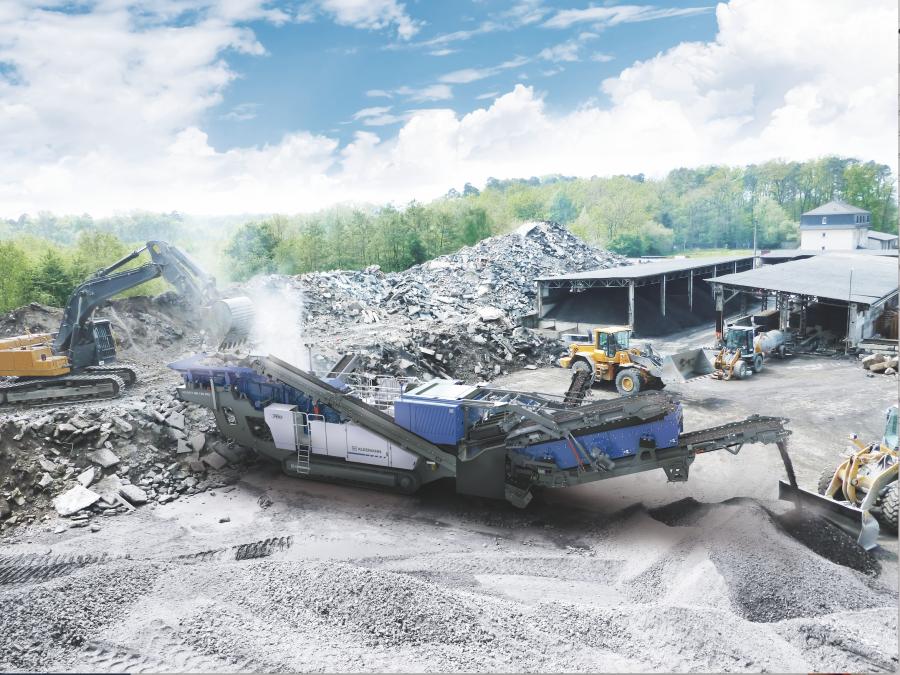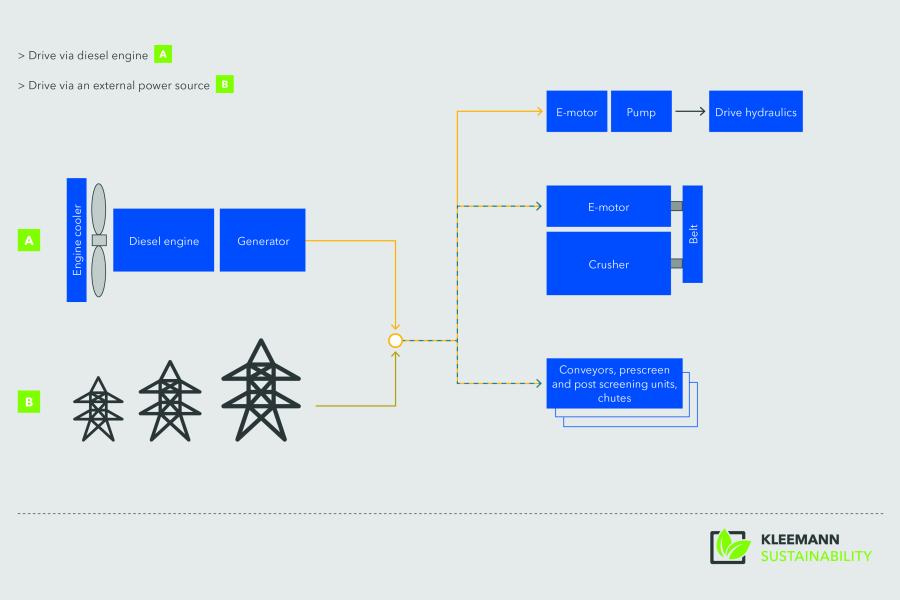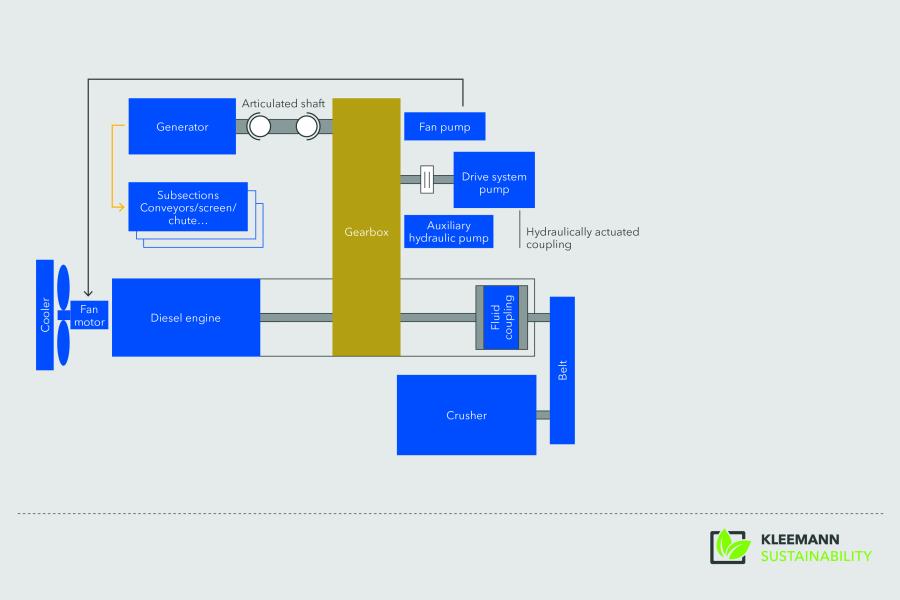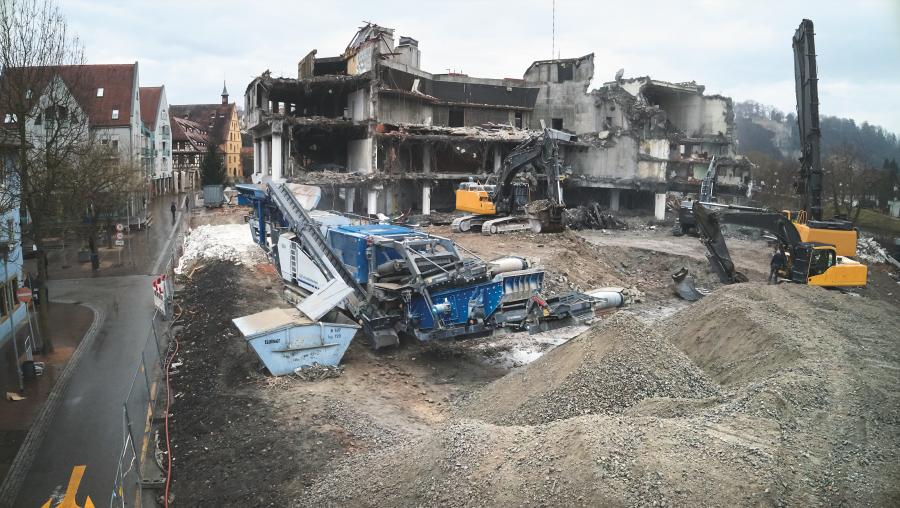
Wed July 05, 2023
Wirtgen Group
Kleemann uses three different drive concepts that offer the best possible solution depending on the tasks at hand. Whereas electric drives score very well with regard to the CO2 footprint, in some situations a fuel-saving diesel drive is the better solution.
E-DRIVE, D-DRIVE and H-DRIVE represent the variants diesel-electric, diesel-direct and diesel-hydraulic.
The decision on the most efficient solution depends on many factors: For example, whether there is a power supply option available on site, whether the machines are used in an urban environment or which local environmental regulations apply.
E-DRIVE — Emission-Free Due to Electric Drive

Plants in the PRO line, such as the MOBICAT MC 120(i) PRO, can be operated completely with electricity or, alternatively, with a diesel engine. The crusher and all conveyor belts are then still driven electrically by a generator.
The E-DRIVE drive concept offers two options: Diesel fuel or all-electric.
All-electric operation is environmentally friendly: there are no CO2 emissions on site. A precondition for this is a good power infrastructure, which is often available in quarries or in larger recycling yards.
If only an insufficient power supply, or none at all, is available, a diesel-electric work option is available — for example, if the complete plant in the quarry is to be moved along the rock face. Power is then supplied from a long cable, which is often too complex, or even no longer possible. In this case, power comes from the fuel-efficient diesel engine. The crusher and all conveyor belts are then still driven electrically by a generator. Depending on the local situation, the E-DRIVE concept offers high flexibility.
D-DRIVE — Direct, Powerful Solution

Crusher direct drive D-DRIVE on the EVO2 crushing plants from Kleemann: The fluid coupling guarantees high operational safety — for operator and machine. All secondary drives, such as prescreen, chutes or conveyor belts, are driven electrically.
The diesel-direct drive D-DRIVE provides power directly from the engine to the crusher. In the last few years, it was possible to reduce consumption, for example, through the load-dependent fan drive of the new EVO2 Generation.
With regard to the degree of efficiency, the diesel-direct drive has the edge in lowering fuel consumption significantly. Due to their compact size and well thought-out transport options, the machines can be positioned in any place on the work site.
If continuous use of the all-electric drive is not possible, the D-DRIVE is the better, more sustainable choice — whenever flexibility is required. This is the case with demolition and processing work in urban areas, but also in road construction where the machines have to be moved along as construction progresses.
H-DRIVE — For Mobile Screening Plants

The Kleemann screening plants use an effective diesel-hydraulic drive. Furthermore, the configuration with Dual Power provides an option for an all-electric power supply. If a mains connection is available, the plant operates on site free of emissions.
The screening plants from Kleemann use an effective diesel-hydraulic drive. In this case, hydraulic pumps operate all machine parts such as screen, belts and drive system.
The power requirements of the screens are considerably lower than a crusher — fuel consumption during operation is therefore more favorable. The optionally available Start-Stop system can reduce consumption even more.
With the configuration with Dual Power, Kleemann screening plants have an option for an all-electric power supply. If a mains connection is available, the plant operates on site free of emissions — for example, in ecologically sensitive areas with strict stipulations.
Summary: Ecological Drive — A Question of Overall Concept
Many factors play a role in the area of sustainability. Energy required for production, transport, storage, sales and disposal are all incorporated in the ecological footprint of the production process.
As far as CO2 emissions during operation are concerned, an all-electric plant is without doubt the best choice, according to the manufacturer. In other cases, you have to weigh up whether supply via an external power source involving high equipment and material costs is more constructive at the end of the day than technology with lower fuel consumption. Ecology also can mean placing your trust in low material usage and high durability.
For more information, visit www.wirtgen-group.com.

Demolition work in inner-city areas is always a challenge. In many cases, an adequate power infrastructure is not available.
 Aggregate Equipment
Aggregate Equipment Articles
Articles Email Updates
Email Updates Sell Your Machines
Sell Your Machines

 Aggregate Equipment
Aggregate Equipment Aggregate Dealers
Aggregate Dealers Aggregate Articles
Aggregate Articles Email Updates
Email Updates Sell Your Machines
Sell Your Machines